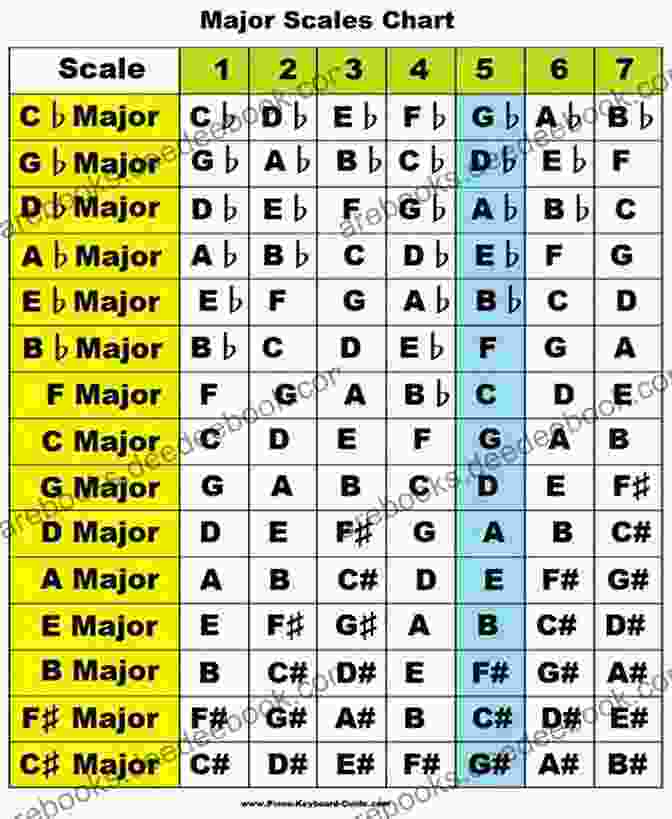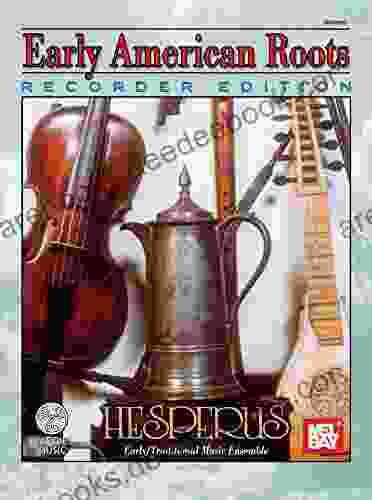Keys, Scales, Chords Made Simple: A Comprehensive Guide for Beginners


4.2 out of 5
| Language | : | English |
| File size | : | 1349 KB |
| Screen Reader | : | Supported |
| Print length | : | 37 pages |
| Lending | : | Enabled |
: Embarking on Your Musical Adventure
Music is a universal language that transcends spoken words and cultural boundaries. Whether you're strumming a guitar, tinkling the ivories of a piano, or belting out a heartfelt melody, understanding the fundamental elements of music theory is crucial for unlocking your musical potential.
In this comprehensive guide, we'll delve into the building blocks of music: keys, scales, and chords. We'll simplify these concepts, making them accessible to even the most novice music enthusiasts. So, grab your instrument, open your ears, and let's embark on this musical adventure together!
Chapter 1: Keys - The Foundation of Harmony
Imagine a house with multiple rooms, each painted a different color. Similarly, in music, keys are like rooms, providing a tonal framework for melodies and harmonies. A key determines the starting point, or tonic, of a scale and the arrangement of sharps or flats.
There are 12 major keys in Western music, each represented by a unique combination of sharps or flats. The most common keys for beginners include C major (no sharps or flats),G major (one sharp),and F major (one flat).
Exploring the Circle of Fifths
Visualize a circle with 12 evenly spaced points, starting from C. Each point represents a key, moving clockwise by fifths. This circle provides a helpful way to understand the relationships between keys and their sharps or flats.
As you move clockwise, sharps are added. For example, G major has one sharp (F#),D major has two sharps (F# and C#),and so on. Conversely, moving counterclockwise adds flats. F major has one flat (Bb),Bb major has two flats (Bb and Eb),and so on.
Chapter 2: Scales - The Blueprint for Melodies
Scales are sequences of notes arranged in ascending or descending order. They provide the building blocks for melodies and help determine the overall character of a piece of music.
Major and Minor Scales
There are two main types of scales: major and minor. Major scales have a bright, cheerful sound, while minor scales evoke a more somber, melancholic mood.
The major scale consists of seven notes with specific intervals: whole step, whole step, half step, whole step, whole step, whole step, half step. The minor scale has three variations: natural minor, harmonic minor, and melodic minor.
Building Scales from Keys
Once you know the key of a piece, you can easily identify the corresponding scale. For example, in the key of C major, the C major scale is used. To build a scale from a key, simply start on the tonic and follow the interval pattern.
Chapter 3: Chords - The Heart of Harmony
Chords are combinations of three or more notes played simultaneously. They provide the harmonic foundation for music, creating richness and depth.
Triads - The Basic Building Blocks
Triads are the simplest type of chord, consisting of three notes: the root, third, and fifth. The root is the fundamental note, the third determines the quality of the chord (major or minor),and the fifth completes the harmony.
Major triads have a bright and uplifting sound, while minor triads evoke a more somber and introspective mood.
Seventh Chords - Adding Complexity
Seventh chords add a richer and more complex sound to music. They include the root, third, fifth, and seventh notes. The seventh can be major, minor, or diminished, further expanding the range of harmonic possibilities.
Chapter 4: Putting It All Together
Now that you have a grasp of keys, scales, and chords, it's time to put them together and create music! Here are some tips for applying your newfound knowledge:
- Use scales to improvise melodies. Start by playing simple melodies within the key of a song.
- Build chords from the scale. Identify the tonic of a song and build chords using the corresponding scale.
- Experiment with different chord progressions. Combine chords to create harmonic movement and interest.
- Listen attentively to music. Pay attention to how keys, scales, and chords are used to create different moods and musical styles.
- Practice regularly. The key to mastering music theory is repetition and practice.
: Unleashing Your Musical Potential
Understanding keys, scales, and chords provides a solid foundation for your musical journey. It allows you to analyze music, create your own compositions, and communicate effectively with fellow musicians.
As you delve deeper into music theory, you'll discover a world of endless possibilities. From classical masterpieces to modern pop anthems, the language of music becomes accessible and expressive.
So, continue your exploration, embrace the joy of music theory, and unlock the full potential of your musicality. Let the keys, scales, and chords be your guiding light as you navigate the vast and vibrant tapestry of music.
Happy music-making!
4.2 out of 5
| Language | : | English |
| File size | : | 1349 KB |
| Screen Reader | : | Supported |
| Print length | : | 37 pages |
| Lending | : | Enabled |
Do you want to contribute by writing guest posts on this blog?
Please contact us and send us a resume of previous articles that you have written.
 Book
Book Novel
Novel Page
Page Chapter
Chapter Text
Text Story
Story Reader
Reader Library
Library Magazine
Magazine Newspaper
Newspaper Shelf
Shelf Bibliography
Bibliography Foreword
Foreword Annotation
Annotation Footnote
Footnote Scroll
Scroll Tome
Tome Bestseller
Bestseller Classics
Classics Library card
Library card Autobiography
Autobiography Reference
Reference Encyclopedia
Encyclopedia Thesaurus
Thesaurus Librarian
Librarian Stacks
Stacks Archives
Archives Periodicals
Periodicals Study
Study Research
Research Scholarly
Scholarly Lending
Lending Reserve
Reserve Journals
Journals Reading Room
Reading Room Rare Books
Rare Books Special Collections
Special Collections Interlibrary
Interlibrary Awards
Awards Book Club
Book Club Emil Tsenov
Emil Tsenov Ashley Jaquavis
Ashley Jaquavis Mark Fitzpatrick
Mark Fitzpatrick Abhishek Kumar
Abhishek Kumar Josh Wright
Josh Wright J Rock
J Rock Sakura Mai
Sakura Mai Sandra Malina
Sandra Malina Lena Wiese
Lena Wiese William Strunk Jr
William Strunk Jr Abbe Smith
Abbe Smith Michael Mackison
Michael Mackison Abigail J Stewart
Abigail J Stewart Katie Powell
Katie Powell Ingersoll Lockwood
Ingersoll Lockwood Christine Manzari
Christine Manzari Alasdair Blair
Alasdair Blair Crafty Nichole
Crafty Nichole Roger Donenfeld M D
Roger Donenfeld M D Gary Clayton Anderson
Gary Clayton Anderson
Light bulbAdvertise smarter! Our strategic ad space ensures maximum exposure. Reserve your spot today!

 DeShawn PowellHandbook of Biofuels Production: A Comprehensive Guide to Sustainable Energy...
DeShawn PowellHandbook of Biofuels Production: A Comprehensive Guide to Sustainable Energy...
 Grant HayesUnveiling the World's Hidden Places and Spaces: A Journey Through Intriguing...
Grant HayesUnveiling the World's Hidden Places and Spaces: A Journey Through Intriguing... Alan TurnerFollow ·13.5k
Alan TurnerFollow ·13.5k Tyler NelsonFollow ·8k
Tyler NelsonFollow ·8k Jason ReedFollow ·12.3k
Jason ReedFollow ·12.3k Gerald ParkerFollow ·9.2k
Gerald ParkerFollow ·9.2k Dennis HayesFollow ·17.2k
Dennis HayesFollow ·17.2k Alec HayesFollow ·2.6k
Alec HayesFollow ·2.6k Stanley BellFollow ·11.1k
Stanley BellFollow ·11.1k Chase SimmonsFollow ·4.9k
Chase SimmonsFollow ·4.9k

 Gabriel Mistral
Gabriel MistralThe Complete Guide for Startups: How to Get Investors to...
Are you a startup...

 Brian West
Brian WestYour 30 Day Plan To Lose Weight, Boost Brain Health And...
Are you tired of feeling tired, overweight,...

 Allen Ginsberg
Allen GinsbergFox Hunt: (Dyslexie Font) Decodable Chapter (The Kent S...
What is Dyslexia? Dyslexia is a...

 Dwayne Mitchell
Dwayne MitchellElectronic Musician Presents: The Recording Secrets...
By [Author's Name] In the world of music,...

 Ralph Waldo Emerson
Ralph Waldo EmersonA Comprehensive Guide to Deep Learning for Beginners
Deep learning is a subfield...
4.2 out of 5
| Language | : | English |
| File size | : | 1349 KB |
| Screen Reader | : | Supported |
| Print length | : | 37 pages |
| Lending | : | Enabled |










